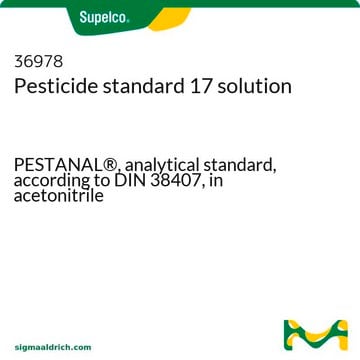34017
Isoproturon-d6
PESTANAL®, analytical standard
Synonyme(s) :
3-(4-Isopropylphenyl)-1,1-dimethylurea-d6
About This Item
Produits recommandés
Qualité
analytical standard
Niveau de qualité
Gamme de produits
PESTANAL®
Durée de conservation
limited shelf life, expiry date on the label
Technique(s)
HPLC: suitable
gas chromatography (GC): suitable
Application(s)
agriculture
environmental
Format
neat
Changement de masse
M+6
Chaîne SMILES
[2H]C([2H])([2H])N(C(=O)Nc1ccc(cc1)C(C)C)C([2H])([2H])[2H]
InChI
1S/C12H18N2O/c1-9(2)10-5-7-11(8-6-10)13-12(15)14(3)4/h5-9H,1-4H3,(H,13,15)/i3D3,4D3
Clé InChI
PUIYMUZLKQOUOZ-LIJFRPJRSA-N
Description générale
Application
- Soil samples using pressurized liquid extraction (PLE) followed by liquid chromatography coupled to mass chromatography (LC-MS) and electrospray ionization-tandem mass spectrometry (LC-ESI+-MS/MS).
- Surface water samples using online solid phase extraction–liquid chromatography–tandem mass spectrometry (SPE–LC–MS/MS).
Informations légales
Produit(s) apparenté(s)
Mention d'avertissement
Warning
Mentions de danger
Conseils de prudence
Classification des risques
Aquatic Acute 1 - Aquatic Chronic 1 - Carc. 2 - STOT RE 2
Organes cibles
Blood
Code de la classe de stockage
11 - Combustible Solids
Classe de danger pour l'eau (WGK)
WGK 3
Point d'éclair (°F)
Not applicable
Point d'éclair (°C)
Not applicable
Équipement de protection individuelle
Eyeshields, Gloves
Faites votre choix parmi les versions les plus récentes :
Déjà en possession de ce produit ?
Retrouvez la documentation relative aux produits que vous avez récemment achetés dans la Bibliothèque de documents.
Notre équipe de scientifiques dispose d'une expérience dans tous les secteurs de la recherche, notamment en sciences de la vie, science des matériaux, synthèse chimique, chromatographie, analyse et dans de nombreux autres domaines..
Contacter notre Service technique









